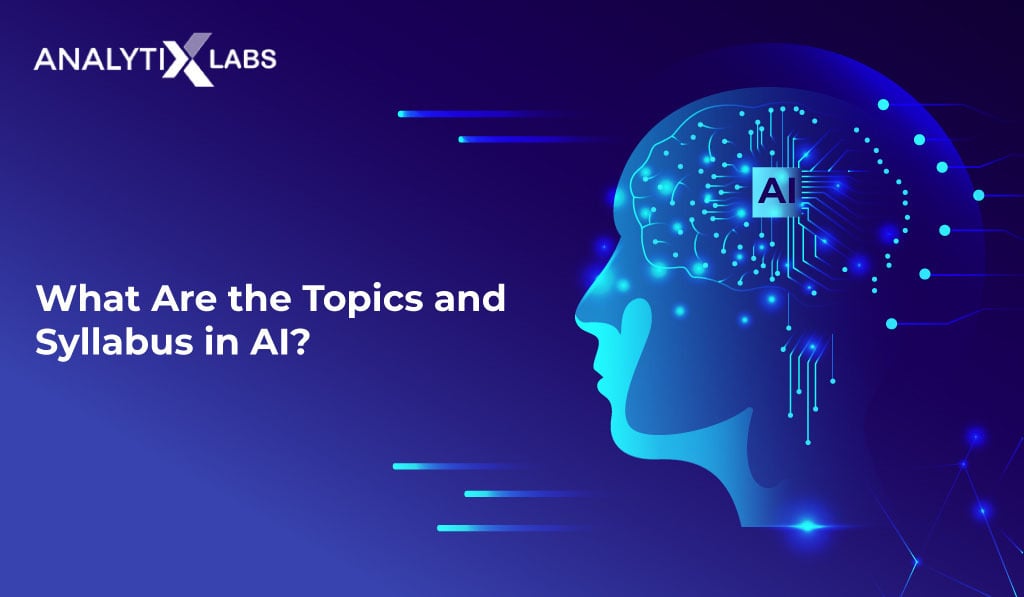Preface
AI is one of the most sought-after technologies of the modern day. In recent times, the need for AI specialists has skyrocketed, making it essential for Data Science and other aspirants to know of AI what exactly they need to learn about it, i.e., what should a proper artificial intelligence course syllabus contain. The readers of this article can expect to have a decent level of understanding of all the underlying phenomena and processes of AI. The article will cover broader topics such as what a practical artificial intelligence syllabus should look like, what AI is all about, its scope in India, etc.
A Brief about the Artificial Intelligence Course Syllabus
Artificial Intelligence (AI) is a wide-ranging branch of computer science concerned with building smart machines capable of performing tasks that typically require human intelligence. This article explains a brief overview of the Artificial Intelligence course syllabus.
A typical Artificial Intelligence course syllabus is as follows-
- Machine Learning
- Deep Learning
- Natural Language Processing
- Robotics
- Artificial Intelligence in Business and Society
- The Future of Artificial Intelligence
More on each of these topics from the ai syllabus will be discussed ahead.
AnalytixLabs is the premier Data Analytics Institute specializing in training individuals and corporates to gain industry-relevant knowledge of Data Science and its related aspects. It is led by a faculty of McKinsey, IIT, IIM, and FMS alumni who have outstanding practical expertise. Being in the education sector for a long enough time and having a broad client base, AnalytixLabs helps young aspirants greatly to have a career in Data Science.
If you want to upgrade your skills in AI, you should take our certificate course in artificial intelligence. Get started today with AnalytixLabs, because, trust me, there has never been a better time than today to get into AI.
What is Artificial Intelligence
Many human mental activities such as writing computer programs, doing mathematics, engaging in common sense reasoning, understanding language, and even driving an automobile are said to demand “intelligence.” Most of the work on building such kinds of systems has taken place in the field called “Artificial Intelligence (AI).” This work has had an experimental and designing direction to a great extent. Drawing from a loosely structured but growing body of computational techniques, AI systems are developed, undergo experimentation, and are improved. This interaction has created and refined a few general AI standards of wide pertinence.
There are three main categories of AI:
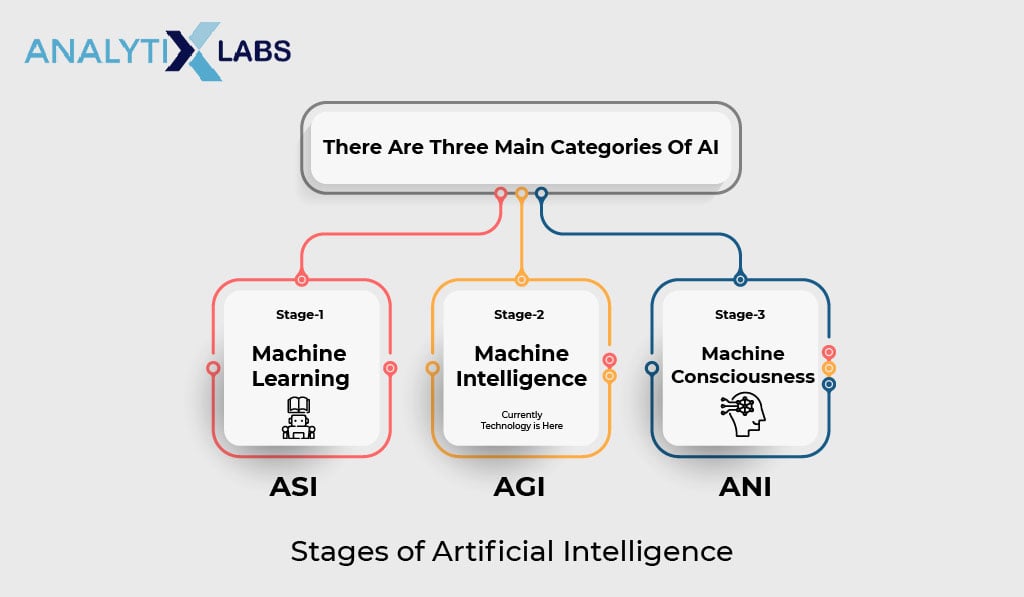
- Artificial Narrow Intelligence (ANI)
- Artificial General Intelligence (AGI)
- Artificial Super Intelligence (ASI)
ANI is considered a “frail” AI, while the other two sorts are delegated “solid” AI. Frail AI is characterized by its capacity to finish a pretty certain responsibility, such as dominating a chess match or recognizing a particular person in a progression of photographs.
As we move into more potent types of AI, such as AGI and ASI, the fuse of more human practices turns out to be more unmistakable, like the capacity to decipher tone and feeling. Chatbots and menial helpers, like Siri, are starting to expose this, yet they are still instances of ANI.
Solid AI is characterized by its capacity contrasted with people. Artificial General Intelligence (AGI) would perform comparably to another human, while Artificial Super Intelligence (ASI)— otherwise called genius—would outperform a human’s knowledge and capacity. Neither types of Strong AI exist yet, yet progressing research in this field proceeds.
Eligibility to do artificial intelligence course
AI is a vast field in itself. Not only does it covers an extensive range of topics, but it also has a lot of depth as the AI algorithms use a lot of advanced mathematics. Thus, the eligibility for a course can depend on the nature of the AI syllabus. However, if the course is not getting into extreme levels of depth (regarding the exact functioning of various AI algorithms), then the typical eligibility would be –
- Working knowledge of analytics tools especially Python for Data Science
- While candidates from different educational backgrounds can take up artificial intelligence courses, having knowledge of mathematical concepts such as Calculus can give one a slight edge in understanding the mathematical functioning of the algorithms.
- Knowledge of basic Data Science is required – this includes data manipulation and statistical modelling.
You may also like to read: How to Become an AI Engineer – Skills, Jobs & Salary
Artificial Intelligence Course Syllabus
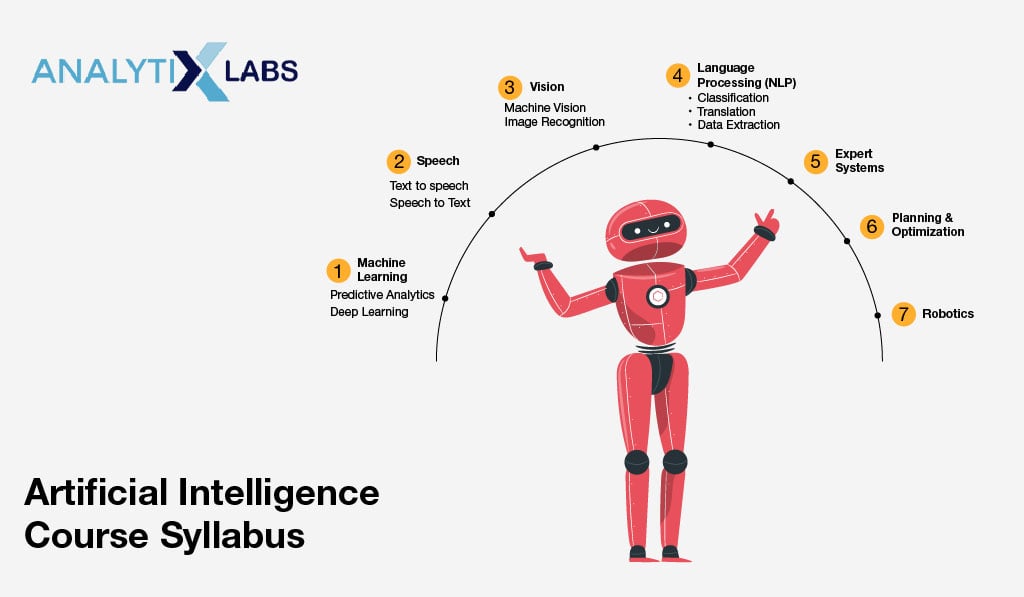
This section explains a typical ai syllabus in detail. The essential concepts which you need to know about the Artificial Intelligence syllabus are as follows.
- Machine Learning
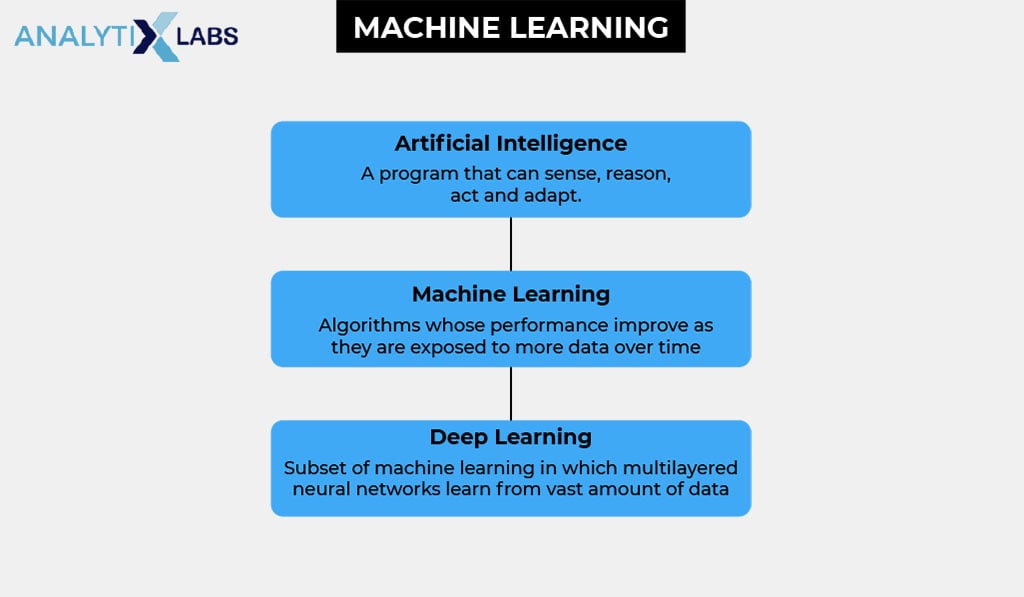
Machine Learning is a part of Artificial Intelligence (AI) and computer science, which centers around the utilization of information and calculations to mimic the way that people learn, bit by bit working on its precision. Machine Learning is a significant part of the ai course syllabus and a developing field of data science. Using numerical, factual, tree-based, and so forth techniques, calculations are prepared to make orders or forecasts, uncovering essential experiences inside information mining projects. These experiences consequently drive dynamic inside applications and organizations in a perfect world affecting key development measurements.
Machine Learning classifiers fall into three essential classifications.
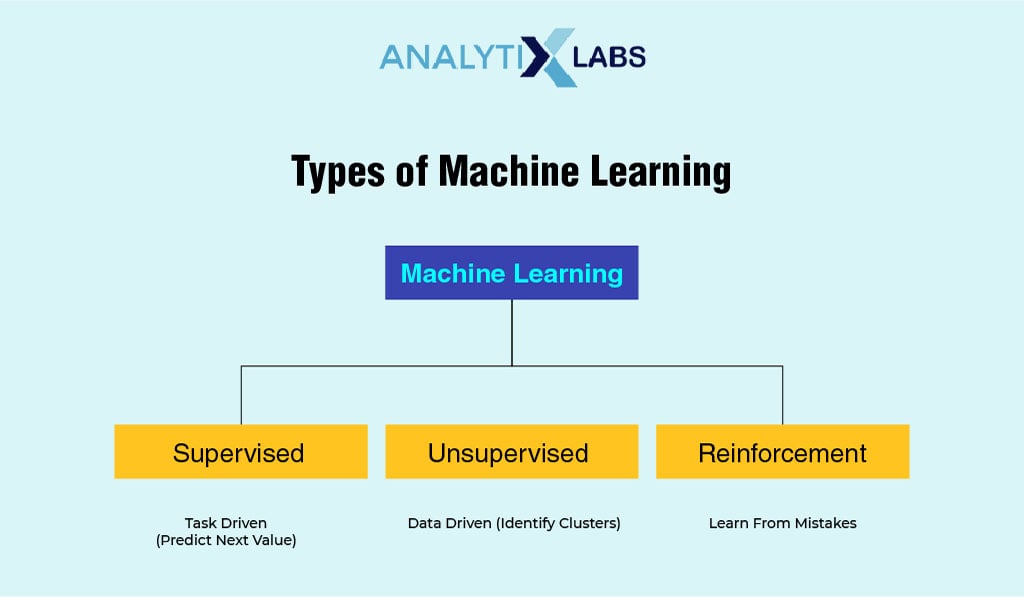
- Supervised machine learning
Supervised learning (also known as supervised machine learning) is defined by its use of labeled datasets to train algorithms in order to classify data or predict outcomes accurately.
Supervised learning assists organizations with tackling an assortment of genuine issues at a colossal scope, for example, classifying spam in a different folder from your inbox.
- Unsupervised machine learning
Unsupervised learning (also known as unsupervised machine learning) uses machine learning algorithms to analyze and cluster unlabeled datasets. These algorithms try to find out hidden patterns or data groupings without the requirement for human intercession.
Its ability to find similarities and variations in data make it absolute for exploratory data analysis, cross-selling strategies, customer segmentation, image segmentation, and pattern recognition. It’s likewise used for feature reduction in a model through the principal component analysis (PCA), and singular value decomposition (SVD) are two standard methodologies for this. Some of the algorithms utilized in unsupervised learning are specific types of neural networks, k-means clustering, probabilistic clustering methods, etc.
Semi-supervised learning
Semi-supervised learning offers a fair compromise between supervised and unsupervised learning. The training phase utilizes a smaller labeled data set to do classification and component extraction from a bigger, unlabeled data. Semi-supervised learning can take care of the issue of having insufficient labeled data (or not having the option to stand to name sufficient data) to train a supervised learning algorithm.
A utilization of semi-supervised learning is a text archive classifier. This is the circumstance where semi-supervised learning is perfect since it is impossible to track down an enormous number of labeled text reports. This is essential because it isn’t time-productive to have an individual peruse whole message records to relegate it to a primary grouping. Thus, semi-supervised learning considers the calculation to gain from a few marked text reports while classifying countless unlabeled text archives in the preparation information.
- Reinforcement machine learning
Reinforcement machine learning is a behavioral machine learning model similar to supervised learning, but the algorithm isn’t trained using sample data.
In Reinforcement learning, an AI algorithm faces a game-like circumstance. The PC utilizes experimentation to find an answer for the issue. To get the machine to do what the software engineer needs, the computerized reasoning gets rewards or punishments for its activities, and it tends to maximize the total reward.
Albeit the architect sets the award strategy, that is, the game’s guidelines–he gives the model no clues or ideas for settling the contest. It’s dependent upon the model to sort out some way to play out the errand to amplify the prize, beginning from absolutely arbitrary preliminaries and wrapping up with refined strategies and superhuman abilities.
- Deep Learning
Machine learning, deep learning, and neural networks are all sub-fields of artificial intelligence. As a matter of fact, deep learning is a sub-field of machine learning inspired by the structure and function of the brain called neural networks. Modern state-of-the-art deep learning aims to train neural network models using the backpropagation algorithm. The most popular deep learning techniques are:
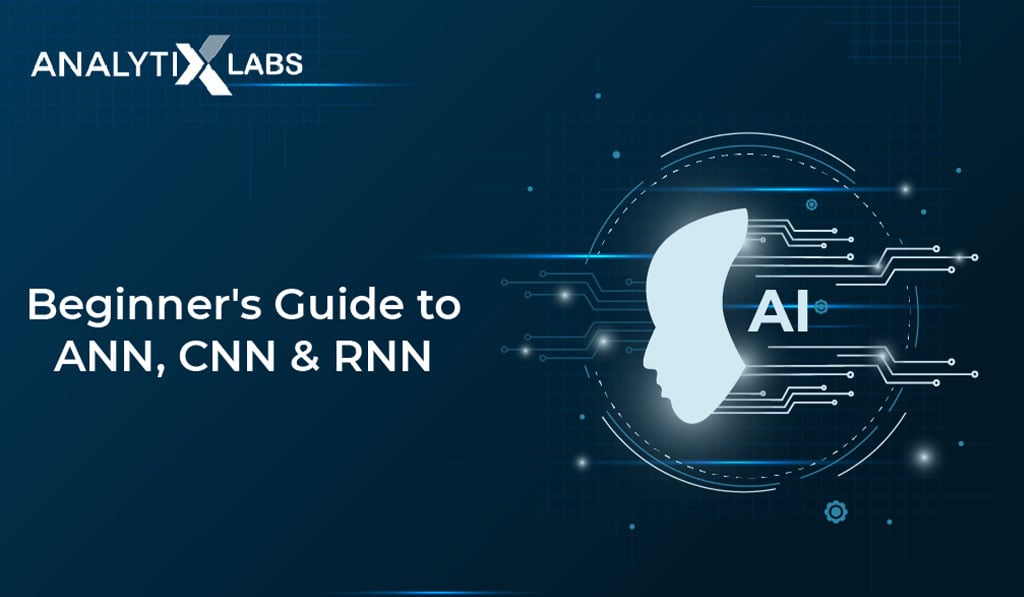
- Artificial Neural Networks (ANN)
Artificial Neural Network is a progression of calculations attempting to mirror the human mind and discover the connection between the arrangements of information. It is being utilized in different use-cases like relapse, characterization, Image Recognition, and others.
One of the most exciting advancements of the previous decade is Artificial Neural Networks, the fundamental piece of deep learning algorithms, the front line of artificial intelligence.
You can thank neural networks for a considerable lot of utilizations you utilize each day, for example, Google’s interpretation administration, Apple’s Face ID iPhone lock, and Amazon’s Alexa AI-powered assistance. Neural networks are additionally behind a portion of the significant artificial intelligence forward leaps in different fields, like diagnosing skin and bosom disease and self-driving vehicles.
The idea and science behind artificial neural networks have existed for a long time. In any case, it has just been in a recent couple of years that the services of neural networks have gone to the real world and aided the AI business rise out of a drawn-out winter.
You may also like to read: Fundamentals Concepts of Neural Networks & Deep Learning
- Convolutional Neural Networks (CNN)
A convolutional neural network, or CNN, is a profound learning neural network intended for handling organized data like pictures. Convolutional neural networks are broadly utilized in computer vision and have turned into the cutting edge for some visual applications, such as image classification, and have also discovered accomplishment in natural language processing for text grouping.
Convolutional neural networks are genuinely adept at getting on patterns in the image data, like lines, angles, circles, or even eyes and faces. This ability makes convolutional neural networks so incredible for computer vision. Dissimilar to prior computer vision algorithms, convolutional neural networks can work straightforwardly on raw image data and needn’t bother with any pre-handling.
- Recurrent Neural Networks (RNN)
Recurrent neural networks (RNN) are the best in the class algorithm for sequential data and are utilized by Apple’s Siri and Google’s voice search. The main algorithm recollects its inputs because of internal memory, making it impeccably appropriate for AI issues that include sequential data. It is one of the algorithms in the background of the stunning accomplishments in deep learning in recent years.
Recurrent neural networks (RNN) are a kind of Neural Network where the outputs from the previous neuron are taken care of as input to the current neuron. In most neural networks, the inputs and outputs are not dependent on one another. However, in situations where it is needed to anticipate the following expression of a sentence, the past words are required, and thus there is a need to remember the past terms. Consequently, RNN appeared, which settled this issue with the assistance of a Hidden Layer. The principle and most crucial component of RNN is the Hidden state, which recalls some data about succession. RNN has a “memory” which recalls all data concerning what has been determined.
- Natural Language Processing
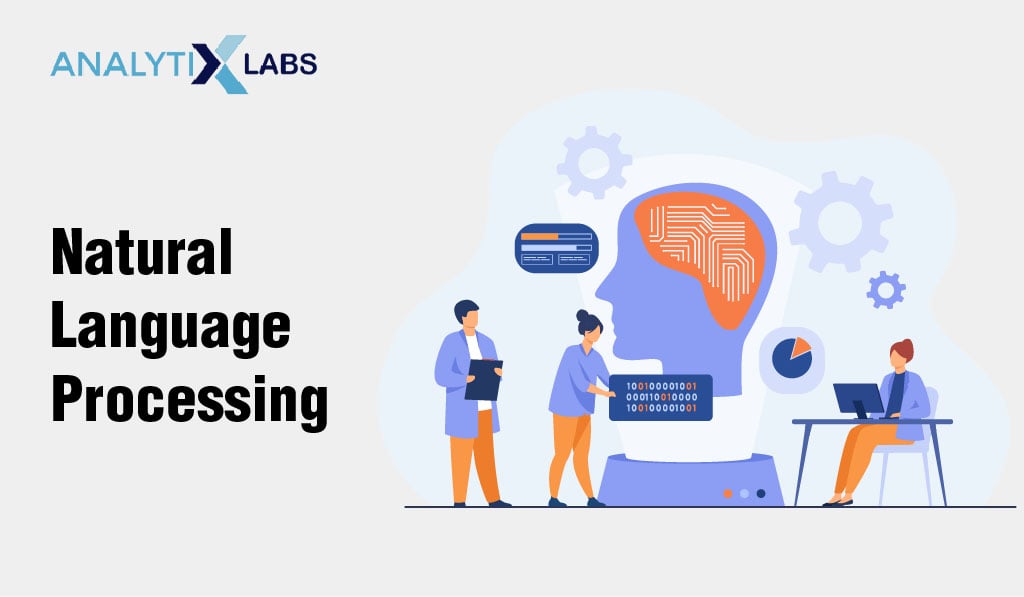
Natural language processing (NLP) is the ability of a computer program to comprehend human language as it is spoken and composed, alluded to as natural language. NLP brings out from many disciplines, including programming and computational semantics, to its most significant advantage of filling the opening between human correspondence and computer understanding. While natural language processing is certifiably not another science, the innovation is quickly propelling on account of expanded interest in human-to-machine correspondences, in addition to accessibility of enormous information, striking figuring and improved calculations.
You might talk and write in English, Spanish, or Chinese as a human. Yet, a computer’s local language – known as machine code or machine language – is generally immense to many people. At your gadget’s most minimal levels, correspondence happens not with words but rather through many zeros and ones that produce sensible activities. For sure, software engineers utilized punch-cards to speak with the principal computers 70 years prior. A moderately modest number of individuals perceived this manual and exhausting interaction. Presently you can say, “Alexa, I like this tune,” and a gadget playing music in your home will bring down the volume and answer, “Alright. Rating saved,” in a humanlike voice. Then, at that point, it adjusts its calculation to play that tune – and others like it – the following time you pay attention to that music station.
We should investigate that communication. Your gadget enacted when it heard you talk, perceived the implicit purpose in the remark, executed activity and gave input in a very much framed English sentence, all in the space of around five seconds. The real connection was made conceivable by NLP, alongside other AI components, for example, machine learning and deep learning.
- Robotics
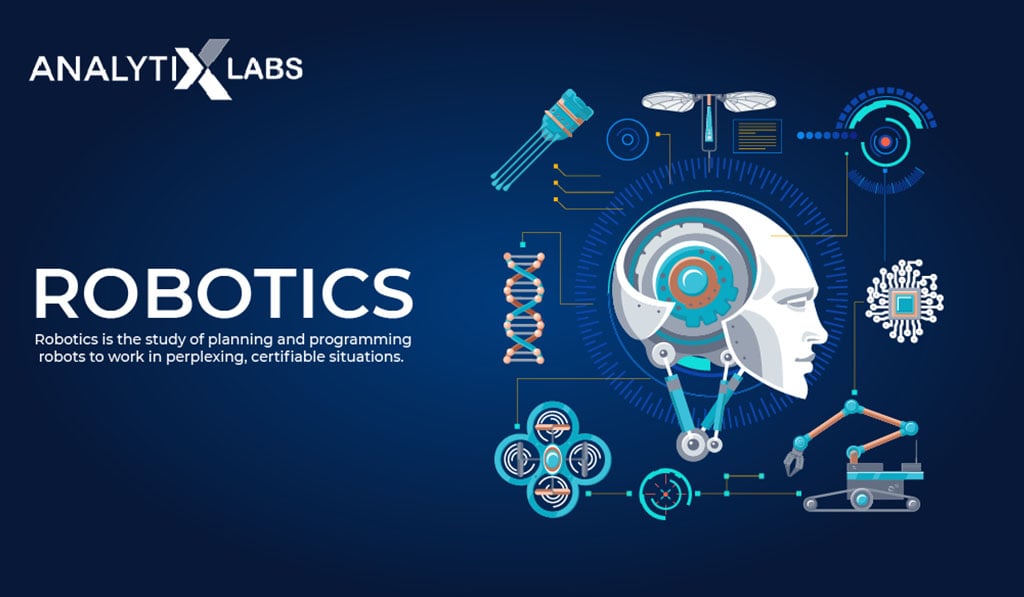
Robotics studies planning and programming robots to work in perplexing, certifiable situations. Somehow or another, robotics is a definitive AI challenge since it requires the joining of practically all spaces of AI. Significant parts of Robotics incorporate.
- Sensing the environment utilizing computer vision and speech recognition
- For preparing guidelines and foreseeing the outcomes of possible activities, natural language processing, data recovery, and thinking under vulnerability are utilized.
- Cognitive modeling and affective computing (frameworks that react to human enthusiastic articulations or copy affections) for connecting and working together with people
- Artificial Intelligence in Business and Society
Artificial intelligence has discovered its place in numerous associations influencing each aspect of society.
- Adoption of AI has been especially boundless in the monetary administrations area. Around 66% of money firms have executed or are adding AI in regions from customer insights to IT efficiencies. Data analysis as of now recognizes fraud.
- AI is additionally helpful in securities exchange investigation. Schroders, the asset administrator, says such frameworks are essentially “sophisticated pattern-recognition methods” yet they can in any case add esteem and further develop efficiency.
- The organizations additionally utilize AI to computerize low-judgment, repetitive back-office processes.
A decent artificial intelligence syllabus should make one acquainted with all such applications of AI in the advanced world.
The Future of Artificial Intelligence
A few areas are toward the beginning of their AI venture, and others are veteran voyagers, and both have far to go. In any case, the effect artificial intelligence is having on our present-day lives is difficult to overlook:
- Transportation: In spite of the fact that it could require 10 years or more to perfect them, autonomous vehicles will one day transport us starting with one spot then onto the next.
- Manufacturing: AI-controlled robots work close by people to play out a restricted scope of errands like get together and stacking, and predictive analysis sensors keep hardware moving along as planned.
- Healthcare: In the nearly AI-beginning field of medical care, illnesses are all the more rapidly and precisely analyzed, drug revelation is accelerated and smoothed out, virtual nursing associates screen patients and enormous information investigation assists with making a more customized patient experience.
- Education: Textbooks are digitized with the assistance of AI, beginning phase virtual guides help human teachers and facial examination measures the feelings of understudies to assist with figuring out who’s battling or exhausted and better tailor the experience to their singular requirements.
- Media: Journalism is outfitting AI, as well, and will keep on profiting from it. Bloomberg utilizes Cyborg innovation to assist making of fast detecting of complicated monetary reports.
- Customer Service: Last yet scarcely least, Google is dealing with an AI collaborator that can put human-like calls to make arrangements at, say, your local beauty parlor. Notwithstanding words, the framework gets setting and subtlety.
You may also like to read: What Is the Future of Data Science and Artificial Intelligence?
Scope of Artificial Intelligence Career in India
The extent of Artificial Intelligence in India is promising. Artificial Intelligence can change every area of the economy to serve society. There isn’t only one innovation under AI, yet there are different helpful advancements like self-improving algorithms, machine learning, big data, pattern recognition. Shortly, there would barely be any industry or area which would be immaculate by this incredible asset in India. This is the justification for why there has been an expanding interest in Artificial Intelligence online courses in India. The name of the designation in the AI area can vary for various firms. A portion of the top title in AI (India – 2021) are as per the following:
- Computational Philosopher – A computational scholar is worried about showing human morals and qualities in AI calculations. For instance, if a robot is being created for doing family errands, it should be intended to tune in and submit to its boss’ orders.
- Robot Personality Designer – A devoted robot character planner plans a machine/robot’s advanced persona.
- Robot Obedience Trainer – A robot acquiescence coach is worried about showing the machine/robot to adhere to guidelines and agree with the imperatives. With an ever increasing number of robots being presented in houses, military methodologies, and so forth, the future extent of Artificial Intelligence is brilliant.
- Autonomous Vehicle Infrastructure Designer – An independent vehicle fashioner creates independent vehicles’ computerized interfaces that assist them with working freely. The splendid Artificial Intelligence future degree can fuel the development of independent vehicles in different enterprises.
- Algorithm Trainers/Click Workers – They work intimately with AI algorithms and train them to perceive guidelines, opinions, dispositions, pictures, discourse, and so on They train an AI calculation to interface with their environmental elements and make fitting actions independently.
- AI Cybersecurity Expert – An AI network protection master creates calculations that can distinguish a robbery/hazard related with the framework and make moves to kill it independently. Since new sorts of cyberattacks are developing each day, AI is being utilized in online protection to recognize them. The future extent of Artificial Intelligence (AI network safety) is likewise brilliant in the Asia Pacific district.
Some other roles in AI careers are as follows
- AI analysts and developers
- AI engineers and scientists
- AI researchers
- AI algorithm specialist
- Robotics expert
- Military and aviation experts
- Maintenance and mechanical engineers
- Surgical AI technicians
You may also like to read: Know about Artificial Intelligence Career Paths | Job Roles & Skills
FAQs – Frequently Asked Questions
Q1. How can I study artificial intelligence?
Before you start your journey towards Artificial Intelligence, first do a little research about what is Artificial Intelligence and its impact on society. If you get a kick and your interest increases in it, then take a look at the syllabus of Artificial Intelligence (which is also explained in this article) to get an overall idea about it.
If you don’t know the python programming language, then first start learning Python, or start with Statistics and Machine learning.
There are various platforms where you can learn Artificial Intelligence online. The best of them are given below; some of them are free, and some charge fees.
These are the best artificial intelligence (AI) courses:
- Artificial Intelligence Engineering (AnalytixLabs)
- AI Programming with Python Nanodegree (Udacity)
- AI For Everyone by Andrew Ng (Coursera)
- AI & Machine Learning Engineering Career Track (Springboard)
- Artificial Intelligence for Trading Nanodegree (Udacity)
- Artificial Intelligence A-Z: Learn How to Build an AI (Udemy)
- Columbia’s Artificial Intelligence MicroMasters Program (edX)
- Introduction to Artificial Intelligence (edX)
- Google AI Education
- Artificial Intelligence: Reinforcement Learning in Python (Udemy)
- The Beginner’s Guide to Artificial Intelligence in Unity (Udemy)
These courses are based on the different needs that you might have for learning AI online. Whether you’re a beginner, software engineer, or non-technical business owner, you will find these courses helpful.
Q2. Is learning AI difficult?
It’s not challenging, however, your ease of learning actually depends a lot on you and your perception. If you have a sound knowledge of fundamentals and practice well, learning Artificial Intelligence would be like a cakewalk for you.
So what’s precisely considered difficult in learning Artificial Intelligence?
You might have heard people or students talk about how difficult deep learning, NLP, neural networks, and other concepts are for them. These concepts aren’t difficult to learn but can be complex to some extent. The trick to learning them quickly is to understand the mathematics involved and the logic behind them and learn them in a structured manner. Once you know the fundamentals of these concepts, you will attempt the challenges and learn in a better place.
You may also like to read: How to Learn Artificial Intelligence? Get Started With AI
Q3. What should I do after 12th in artificial intelligence?
While it’s a good idea and even a wise one to decide to pursue your career in Artificial Intelligence at an early stage, a good amount of planning is required, though.
As part of planning, you have to decide how you want to be educated. For this, you will have two options.
- At first, there are tons of resources available for learning AI online and for self-study. Platforms like Coursera, Udacity, Udemy etc. have many specialised courses in Artificial Intelligence and Machine Learning. A proper research for the best course which suits you is required here before you start learning online. On YouTube also many scholars and institutes have dedicated playlists for Artificial Intelligence, go through them.
- The second method is that you go for a job-focussed Certification Artificial Intelligence Course. Enrol for certificate programs, diploma or graduation programs in Artificial Intelligence and Machine Learning. This provides you with a more personalised approach and a better learning experience for some. There are many universities also that are offering dedicated ai course syllabus in India. Do the research and choose the best one that suits you.
Conclusion
The field of AI is highly dynamic. An excellent artificial intelligence course syllabus should not only talk about the various algorithms of AI. Still, it should give ideas about the other aspects of AI such as Machine Learning, Natural Language Processing, Learning setup. Not only this but the future scope of AI should also be considered in a proper artificial intelligence syllabus. As we advance the reader must remember the knowledge gained from this article when venturing into the field of AI and selecting a course.
You may also like to read:
1. Data Science vs Machine Learning vs Artificial Intelligence with Example

